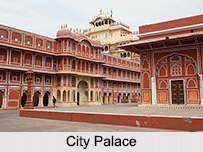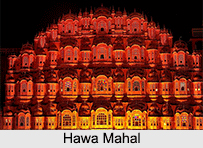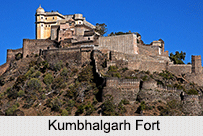 Historical buildings in Rajasthan are scattered throughout the state displaying the royal tradition. Once the land of the brave and aristocratic Rajputs it is dotted with forts, palaces, `chhatris` and `havelis`. Till date these historical buildings are thronged by numerous tourists who cannot stop appreciating these exquisite pieces of art. While most of these were dwelling places for the Rajasthani people, they reflect the expert craftsmanship of that era. It also shows the superb artistic taste of the Rajasthani people.
Historical buildings in Rajasthan are scattered throughout the state displaying the royal tradition. Once the land of the brave and aristocratic Rajputs it is dotted with forts, palaces, `chhatris` and `havelis`. Till date these historical buildings are thronged by numerous tourists who cannot stop appreciating these exquisite pieces of art. While most of these were dwelling places for the Rajasthani people, they reflect the expert craftsmanship of that era. It also shows the superb artistic taste of the Rajasthani people.
The historical buildings in Rajasthan are defined by massive walls, strategic locations and grandeur. These were also the dwelling places for the royal families and `nawabs`. During the hours of crisis the subjects also took shelter within the fortress. While most of the forts in Rajasthan are build in Rajasthani style some also mirror an amalgamation of Rajasthani and Mughal styles. This is referred to as Indo-Saracenic architecture. The tourists will come across the forts in almost all the parts of Rajasthan. The forts were built in different kinds of stones among which Amer Palace (Fort ), Jaigarh Fort, Nahargarh Fort, Jaisalmer Fort, Junagarh Fort, Mehrangarh Fort and Kumbhalgarh Fort can be named.
Architecture of Historical Buildings in Rajasthan
The palaces were generally divided into several spacious parts. Largely these were divided into men`s quarter and women`s quarter. The medieval palaces had the defensive character of the Rajput constructions. These historical structures had narrow corridors, stairways, concealed passages and ramps. The usage of stone in creating these structures can also be seen. The making of frescos was also an indispensable part of the palaces in Rajasthan.
The Chhatris or cenotaphs are also included in the list of the historical buildings in Rajasthan. These were built either at the funeral pyres or at the place of death of the Rajput warriors. This was a way of glorifying his death. Chhatris are elevated, dome-shaped pavilions used as an element in Indian architecture, or funerary sites in India. Chhatris are basic element of Hindu as well as Mughal architecture. The term "chhatri" connotes umbrella or canopies which are built on the cremation sites of wealthy or distinguished individuals in the Shekhawati region of Rajasthan.
The tradition of Rajasthan enabled constructing `havelis` which were the residences of the Marwaris or traders that were beautifully designed by the professional artisans and several of these fine sandstone buildings are still in good condition. Some of the most renowned `havelis` of Rajasthan are "Salim Singh ki Haveli" which was built about 300 years ago.
Famous Historical Buildings in Rajasthan
The historical buildings in Rajasthan include palaces in Rajasthan that reflect the opulence with which the rulers in Rajasthan used to live their lives. The popular Historical Buildings in Rajasthan are as follows:
City Palace: City Palace is situated in Jaipur. It was built in 18th century. This palace has an architectural style which mixes Indian and European style. The first main component of this palace is the doorway. There are three doorways and each one is magnificence by itself.
Hawa Mahal: Hawa Mahal stands straight as the doorway to the City of Jaipur. An imperative landmark in the city, Hawa Mahal is an embodiment of the Rajputana architecture. The pyramid shape of this early monument is a tourist attraction having 953 small windows.
Umaid Bhawan Palace: Umaid Bhavan Palace is located in Jodhpur. This palace has 347 rooms, banquet hall, many courtyards and others.
Havelis of Jaisalmer: "Patwon ki Haveli" is the most elaborate and wonderful of all the Jaisalmer havelis. It stands in a thin lane and one of its apartments is painted with spectacular murals. "Salim Singh ki Haveli" was built about 300 years ago and a part of this is still being used as dwelling. "Nathmal ki Haveli" was also a prime minister`s house and two brothers carved its left and right wings, which are alike in their looks.
Lake Palace: It is an island palace and is situated in the scenic waters of the Pichola Lake. Made up of white marble, it has now been converted into a fabulous heritage hotel with beautiful pavilions and landscaped gardens.
Vijay Stambh: It is a nine-storied 37 metres high construction with sculptures of a secular nature to elaborate the exteriors. Maharaja Kumbha built it in the honour of his victory over the Muslim rulers of Malwa and Gujarat in 1440.
Jantar Mantar: Jantar Mantar of Jaipur, the `Yantralaya` of Sawai Jai Singh II built on his designs, is the major of five astronomical observatories founded by him in 1716.
Palace of Padmini: The palace is located in the Chittorgarh fort and was built in the 13th century for the legendary Queen Padmini whose gorgeousness resulted in the historic battle between Allauddin Khilji and Rana Ratan Singh.
Badal Mahal: Badal Mahal is a two storey palace. The whole building of the palace is parted into two organized mahals called the Mardana Mahal and the Zanana Mahal. Badal Mahal is the maximum point in the Kumbhalgarh Fort. Notably recognized as the `Palace of Clouds` it is located at the top of the Kumbhalgarh Fort.
Badi Mahal: Badi Mahal is also recognized as Garden Palace and is a wonderful structure which was constructed during 17th century. This Badi Mahal is also known as the Men`s section of the City Palace.
Balsamand Lake Palace: The Balsamand Lake Palace is a traditional hotel which is having 10 royal suites and 26 other rooms in the Balsamand Garden Retreat.
 Jaswant Thada: Jaswant Thada is prominently known as the `Taj Mahal of Mewar`. It has a marvellous marble monument which is constructed by Maharaja Jaswant Singh II who was the 33rd Rathore ruler of Jodhpur. His son, Maharaja Sardar Singh, built the memorial in the 19th century.
Jaswant Thada: Jaswant Thada is prominently known as the `Taj Mahal of Mewar`. It has a marvellous marble monument which is constructed by Maharaja Jaswant Singh II who was the 33rd Rathore ruler of Jodhpur. His son, Maharaja Sardar Singh, built the memorial in the 19th century.
Sheesh Mahal: Sheesh Mahal is creatively constructed by embellishment of ceilings and walls by the wonderful and miniature work of mirror pieces. Sheesh Mahal of Jaipur is well-liked with the name of `Hall of Mirrors`.
Ranakpur Jain Temple: The famous Jain temple at Ranakpur is devoted to Tirthankara Rishabhanatha. The temple honours Rishabhanatha, the first Tirthankara of the present half-cycle.
Kumbhalgarh Fort: Kumbhalgarh fort is situated in Aravalli hills of Rajsamand district. This fort has the second longest wall after the Great Wall in China. This fort was built in 15th century and this is the birth place of celebrated Maharana Pratap. This fort is a world heritage site and second largest fort in the state.
Ranthambore Fort: It is situated on the hills of Thanbhore. This fort summarizes many temples, palaces, barracks and other attractions.
Mehrangarh Fort: Mehrangarh fort is one of the principal forts in the world. It is situated in Jodhpur on a hill top which is 400 meter above the land.
Jaisalmer Fort: It was built in 12th century. It is called as the golden fort as the fort glows yellow in the sun because of sandstone walls. This fort obscures many palaces, havelis, temples, residences and others.
Chittorgarh Fort: This fort is situated in Udaipur. It is a wonderful fort that stands on the peak of a hill. This fort covers 700 acres of land.
Amer Fort: This fort was built in 17th century in a combination of Hindu architecture and Muslim architecture style. Light show is conducted every evening. This fort has palaces, temples, gardens and many others.



















